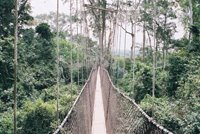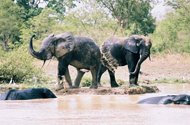Are forest and savannah elephants of the same species?
 There is much debate on whether the forest and savannah elephant are two different species. The impetus of the trip to Ghana was to assess if the forest elephant - Loxodonta Cyclotis also known as the ‘Pygmy Elephant’ represents a distinct anatomical or genetic form from the other elephants. The deciding factor will have important implications for their conservation. Working with Professor Adrian Lister an expert in elephants and the Scientific Exploration Society we set out on our mission.
There is much debate on whether the forest and savannah elephant are two different species. The impetus of the trip to Ghana was to assess if the forest elephant - Loxodonta Cyclotis also known as the ‘Pygmy Elephant’ represents a distinct anatomical or genetic form from the other elephants. The deciding factor will have important implications for their conservation. Working with Professor Adrian Lister an expert in elephants and the Scientific Exploration Society we set out on our mission.Having arrived in Accra the capital of Ghana, we headed to Kakum rainforest, where less than 100 forest elephants exist. In our limited number of days it would be a rare site to see one of these magnificent elephants. However, we were fortunate enough to locate fresh elephant tracks and dung, from this we could evaluate the size of this small elephant, 2-2.5m at the shoulder.
 Kakum is a wonderful rainforest to visit with it lush vegetation, never short of a grapefruit, banana or cocoa pod on our trek. The canopy walk is one of a few in the world and gave us the opportunity to view the forest from the magnificent tree tops. The fresh air was heavenly and the ambient sounds that echoed the forest made a magical nights sleep alongside a glass of chardonney.
Kakum is a wonderful rainforest to visit with it lush vegetation, never short of a grapefruit, banana or cocoa pod on our trek. The canopy walk is one of a few in the world and gave us the opportunity to view the forest from the magnificent tree tops. The fresh air was heavenly and the ambient sounds that echoed the forest made a magical nights sleep alongside a glass of chardonney. Stocking up with reserves for the next part of the trip, our team headed up north to Mole National Park where rainforest becomes savannah. Mole NP is one of the international sites for monitoring the illegal killing of elephants. Sadly locals are ill equipped to stamp out poachers and to monitor the elephant numbers.
Stocking up with reserves for the next part of the trip, our team headed up north to Mole National Park where rainforest becomes savannah. Mole NP is one of the international sites for monitoring the illegal killing of elephants. Sadly locals are ill equipped to stamp out poachers and to monitor the elephant numbers.On arrival we set up camp on the cliff top over looking a breath taking panoramic view of the savannah. Below are two large pools. Each day, with two armed guards, we would descended
 the cliff side to study, photograph and document the elephants which enjoyed bathing there. I felt very blessed to be able to photograph them tussling, playing and welcoming other elephant groups to the pool. It turned out that all the elephants at the pool were male. The female groups were more secretive. On one particular day we were fortunate enough to observe two matings when an adult female in oestrus appeared at the pool, avidly pursed by the males. This was quite extraordinary as normally it is the male that goes in search of the females.
the cliff side to study, photograph and document the elephants which enjoyed bathing there. I felt very blessed to be able to photograph them tussling, playing and welcoming other elephant groups to the pool. It turned out that all the elephants at the pool were male. The female groups were more secretive. On one particular day we were fortunate enough to observe two matings when an adult female in oestrus appeared at the pool, avidly pursed by the males. This was quite extraordinary as normally it is the male that goes in search of the females. Another part of our day was to span certain areas of the savannah to record elephant dung piles! Using GPS equipment to map out the transects and the position of the droppings, a somewhat anal pursuit we could calculate the number of elephants in a given area. This was important especially in the denser areas between the forest and savannah where it was difficult for aerial surveys to be conducted. Our data will be analysed in collaboration with colleagues of Adrian Lister at the University of California and Ougandougou (capital of Burkina Faso). The reports will also go to Ghana Wildlife Service to help with their conservation efforts.
Another part of our day was to span certain areas of the savannah to record elephant dung piles! Using GPS equipment to map out the transects and the position of the droppings, a somewhat anal pursuit we could calculate the number of elephants in a given area. This was important especially in the denser areas between the forest and savannah where it was difficult for aerial surveys to be conducted. Our data will be analysed in collaboration with colleagues of Adrian Lister at the University of California and Ougandougou (capital of Burkina Faso). The reports will also go to Ghana Wildlife Service to help with their conservation efforts.Range finders, combined with accurate photographic methods, we were able to estimate the shoulder heights of individuals, on our treks. The elephants at Mole were of intermediate size
 that suggests that the elephants on the geographical boundary between forest and savannah may be of hybrid origin. Hence, the two types of elephants could be regarded as sub-species of a single African elephant species, rather than two distinct sub-species (non interbreeding) as some recent studies have suggested.
that suggests that the elephants on the geographical boundary between forest and savannah may be of hybrid origin. Hence, the two types of elephants could be regarded as sub-species of a single African elephant species, rather than two distinct sub-species (non interbreeding) as some recent studies have suggested.Our adventures through the savannah gave us a fantastic opportunity to see observe other wildlife, from lion and hyaena tracks, aardvark burrows, kobs and birds... Around the camp were warthogs, lizards that seem to spend their days doing impressive push ups to attract females (a good advertisement for a beer, I think) and mischievous baboons and vervet monkeys whose only ambition was working out different ways to steal our lunch, at times there were some quite heated moments. One of out team members threw a stone to scare the baboons away albeit the baboon caught the stone, leading the comment that next they’ll be applying for passports - a scary thought.
 Near Mole in Larabanga we visited a 15th Century Mosque made of mud, which in my mind resembles that of a large termite mound. It was great to meet the local chief of the village and watch the children running around so freely. Their black board was the side of a mud house and the floor their work desk. I felt a little sad, that in our western society, we are so conditioned by the media coverage of child abduction that our children cannot live so liberally. One evening the school children from Damanko, came to entertain us at the camp with their tribal songs and dance, simple yet, absolutely hypnotic. They really know how to party.
Near Mole in Larabanga we visited a 15th Century Mosque made of mud, which in my mind resembles that of a large termite mound. It was great to meet the local chief of the village and watch the children running around so freely. Their black board was the side of a mud house and the floor their work desk. I felt a little sad, that in our western society, we are so conditioned by the media coverage of child abduction that our children cannot live so liberally. One evening the school children from Damanko, came to entertain us at the camp with their tribal songs and dance, simple yet, absolutely hypnotic. They really know how to party. I recorded the sounds of the jungle at night and day, through to the locals dancing. Whilst trekking I interviewed and videoed my guard, to hear some of his beautiful stories about the nature of elephants and the locals belief. One particular elephant called peoples friend, a magnificent and graceful male elephant quite pale in colour would visit the campsite each night to take in the scent of the new arrivals. He would quietly walk around putting his trunk up to the windows of the chalets and tents. An elephant can retain a scent for up 16 years. They reckonise the poachers when they return just from tracing the scent in the wind.
I recorded the sounds of the jungle at night and day, through to the locals dancing. Whilst trekking I interviewed and videoed my guard, to hear some of his beautiful stories about the nature of elephants and the locals belief. One particular elephant called peoples friend, a magnificent and graceful male elephant quite pale in colour would visit the campsite each night to take in the scent of the new arrivals. He would quietly walk around putting his trunk up to the windows of the chalets and tents. An elephant can retain a scent for up 16 years. They reckonise the poachers when they return just from tracing the scent in the wind.There is much to be discovered about elephants from they way they communicate with each other over distances of 250 km away just from vibrations they pick up through there feet, to
 the way they socialise and record data, relying more on scent and vibrations than vision. The myths in different cultural beliefs and religions from Buddhist, Hindu to Egyption all look upon the elephant as a great protector. It is said they are the keepers of wisdom and knowledge in the cosmos. Truly a magical and much loved animal, whose lives should always be respected.
the way they socialise and record data, relying more on scent and vibrations than vision. The myths in different cultural beliefs and religions from Buddhist, Hindu to Egyption all look upon the elephant as a great protector. It is said they are the keepers of wisdom and knowledge in the cosmos. Truly a magical and much loved animal, whose lives should always be respected.Drawing to the end of our trip , I decided to continue my journey to Wechiau Community Hippo Sanctuary, near Wa, with two others from the group. Hiring one of the drivers we continued up north on our next adventure.
To view Miss Lontay's photographic portfolio please visit: www.alisonlontay.co.uk

